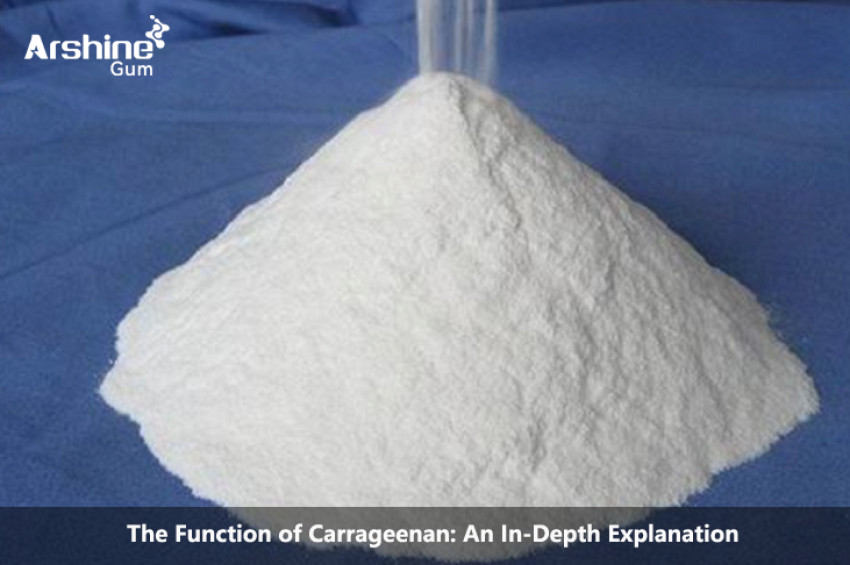
Carrageenan is a natural hydrocolloid extracted from various species of red seaweeds belonging to the Rhodophyceae family. It has been used for centuries in food and non-food applications due to its unique gelling, thickening, stabilizing, and emulsifying properties. Carrageenan's versatility makes it a valuable ingredient in a wide range of products, from food and beverages to pharmaceuticals, cosmetics, and industrial applications. In this in-depth explanation, we will explore the functions and applications of carrageenan, its different types, and its safety profile.
Carrageenan can be classified into three main types based on its chemical structure and properties:
Iota Carrageenan:Iota carrageenan forms soft and elastic gels when combined with calcium ions. It is commonly used in dairy products, such as puddings, custards, and soft cheeses, to provide a smooth and creamy texture.
Kappa Carrageenan:Kappa carrageenan forms firm and rigid gels when combined with potassium ions. It is widely used in various food products, including processed meats, jellies, and gummy candies, for its gel-forming properties.
Lambda Carrageenan:Lambda carrageenan does not gel, but it is a powerful thickening and stabilizing agent. It is commonly used in dairy products, salad dressings, and sauces to enhance their texture and stability.
Gelling Properties:
One of the most important functions of carrageenan is its ability to form gels. The type of gel formed depends on the type of carrageenan used and the presence of specific cations, such as calcium or potassium ions. The gelling process involves the binding of carrageenan molecules to form a three-dimensional network, trapping water and other ingredients within the gel structure.
In kappa carrageenan, for instance, the presence of potassium ions induces the formation of a firm and rigid gel. This gelation is reversible, meaning the gel will dissolve upon heating and reform upon cooling. This thermoreversible gelling property makes kappa carrageenan suitable for a wide range of food applications, such as in gummy candies, confectionery, and fruit jellies.
Iota carrageenan, on the other hand, forms soft and elastic gels in the presence of calcium ions. These gels have a more delicate texture and are often used in dairy-based products like puddings and custards to impart a smooth and creamy mouthfeel.
Thickening and Stabilizing Agent:
In addition to gelling, carrageenan functions as a thickening and stabilizing agent. When dispersed in a liquid, carrageenan molecules interact with water molecules, leading to increased viscosity and a more robust texture. This thickening property enhances the mouthfeel and texture of food and beverage products.
Carrageenan also acts as a stabilizing agent by preventing the separation or syneresis of ingredients in a formulation. In dairy products, for example, carrageenan helps maintain the stability and homogeneity of the product, preventing whey separation and maintaining a smooth consistency.
Emulsification Properties:
Carrageenan exhibits emulsification properties, which means it can stabilize oil-in-water emulsions. When added to a mixture of oil and water, carrageenan forms a stable emulsion, preventing the separation of the two immiscible phases. This emulsification property is valuable in various food products, such as salad dressings, ice cream, and processed meats, where it contributes to the desired texture and stability.
Water-Binding Capacity:
Carrageenan has an excellent water-binding capacity, which helps retain moisture in food products and prevents them from becoming dry and crumbly. This water-holding property is particularly beneficial in processed meats, where carrageenan helps maintain juiciness and improve overall product quality.
Applications in Food Industry:
Carrageenan finds widespread use in the food industry due to its multifunctional properties. Some common applications include:
Dairy Products:Carrageenan is widely used in dairy products like ice cream, yogurt, chocolate milk, and cottage cheese to improve texture, stability, and mouthfeel.
Confectionery:Carrageenan is used in gummy candies, fruit jellies, and marshmallows to create the desired texture and prevent syneresis.
Meat and Seafood Products:Carrageenan is added to processed meats, such as sausages and deli meats, to improve water retention, texture, and sliceability.
Bakery Products:Carrageenan is used in bakery items like cakes, pastries, and fillings to improve texture and moisture retention.
Beverages:Carrageenan is added to beverages like chocolate milk, fruit juices, and nutritional drinks to prevent sedimentation and improve stability.
Applications in Non-Food Industries:
Apart from the food industry, carrageenan finds applications in various non-food industries:
Pharmaceuticals:Carrageenan is used as a gelling and thickening agent in pharmaceutical formulations, such as gels, ointments, and suspensions.
Cosmetics and Personal Care Products:Carrageenan is added to cosmetics and personal care products, such as lotions, creams, and shampoos, for its thickening and stabilizing properties.
Biotechnology:Carrageenan is used in biotechnology for the encapsulation of bioactive compounds and drug delivery systems.
Medical Devices:Carrageenan is used in medical devices, such as wound dressings and controlled-release systems.
Industrial Applications:Carrageenan is utilized in various industrial applications, such as in the production of coatings, adhesives, and textile printing.
Safety Profile:
Carrageenan has been extensively studied for its safety as a food ingredient and additive. Regulatory authorities, such as the U.S. Food and Drug Administration (FDA) and the European Food Safety Authority (EFSA), have reviewed scientific data and affirmed the safety of carrageenan for use in food at specified levels. It is generally recognized as safe (GRAS) when used within approved concentrations.
However, concerns have been raised about a specific form of carrageenan called "degraded carrageenan" or "poligeenan," which is produced through harsh chemical processes. Poligeenan has distinct properties and is not used as a food additive. It is essential to differentiate between food-grade carrageenan and poligeenan, as they are not the same substance and have different applications and safety profiles.
In conclusion, carrageenan is a versatile and valuable ingredient with multifunctional properties. Its ability to form gels, act as a thickening and stabilizing agent, and contribute to emulsification makes it a widely used additive in the food industry. Carrageenan's applications extend beyond food to the pharmaceutical, cosmetic, and industrial sectors, where it serves as a valuable ingredient in various formulations and products. As a natural hydrocolloid derived from seaweeds, carrageenan has a well-established safety profile, making it a trusted ingredient in a wide range of consumer products.
https://www.arshinegum.com/Company-news/the-function-of-carrageenan-an-in-depth-explanation




